What is a Matte Painting?
A practically or digitally created representation of a set, landscape or location to create the illusion of a real environment.
Matte paintings are one of the original VFX (Visual Effects) techniques used in film making. Originally used in photography, matte paintings have evolved from painted glass panels to entire 3D digital worlds.
A matte painting is often a painted glass pane that is used to show a landscape or large set piece. Matte paintings are either filmed on set, where they are framed to look like a physical set piece, or they are combined with live footage in post production.
Before going in depth, here is a look at the use of matte paintings by Industrial Light and Magic.
History of Matte Paintings
Since the mid-19th century, photographers were experimenting with double-exposure to create composite images.
Georges Méliès used the matte painting technique in many of his films. In the 1898 film “Un Homme de Têtes” – “Four Heads Are Better Than One” Méliès would use a glass pane painted black to create a matte. When shooting on film, the black matte kept light from reaching the camera. But since a portion of the film was not exposed to light, it would leave part of the frame empty.
Méliès would then rewind the film and set up an opposite matte. By removing the original matte and blacking out everything else, the film would now fill in the blanks. This was the resulting sequence.
In 1907 matte painter Norman Dawn would use glass paintings in his film “Missions of California”. Many of the missions he was filming had been partially destroyed. He would use matte paintings to make the buildings whole again.
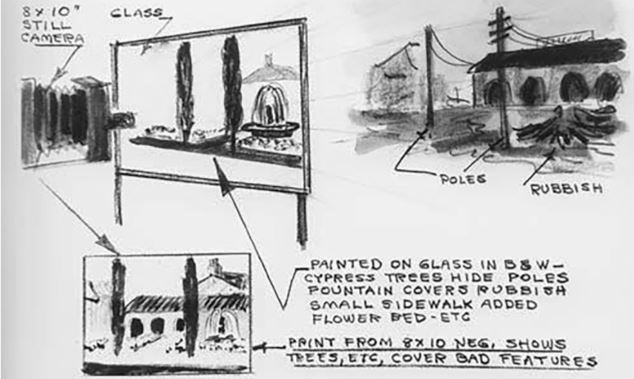
The Travelling Matte
Using glass panes to create matte paintings became the standard for VFX backgrounds, but it meant that the camera had to be still. As any movement would destroy the illusion.
However, in 1918 a new process was created by Frank Williams. The Williams process placed actors in front of black backgrounds, then the film would be copied to create high contrast negatives. These negatives then became a white silhouette of the actors.
The Williams Process was used throughout the late 20s and into the 1930s. It was probably most famously used in 1933s “The Invisible Man”.

Actor Claude Rains wore a black velvet suit underneath his costume. He stood in front of a black background and removed his costume, revealing the black velvet suit underneath.
The Williams Process was the predecessor to the blue and green screen compositing we have today.
Matte paintings were still traditionally used on many major motion pictures throughout the 1930s as well: such as the barracks on “All Quiet on the Western Front”, the castle in “Dracula” and Skull Island in “King Kong”.
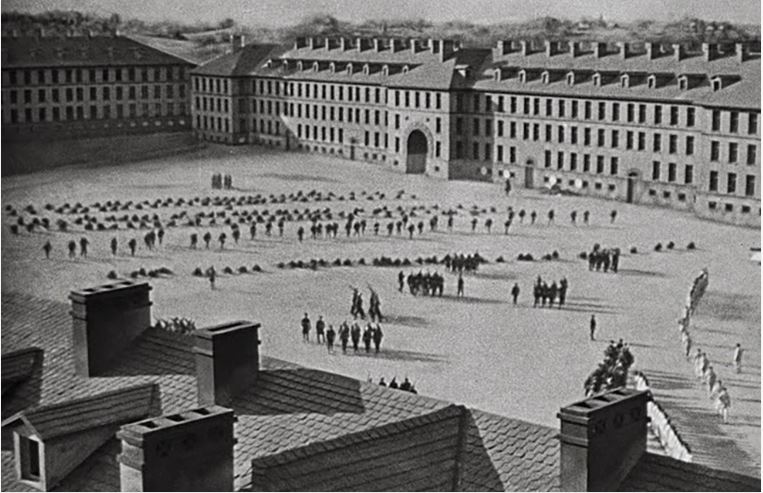
Examples of Matte Paintings
Alfred Hitchcock was using glass pane matte paintings throughout the 40s and well into the 60s. They were prominently used in “North by Northwest” and “The Birds”.
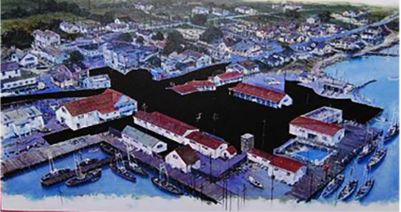
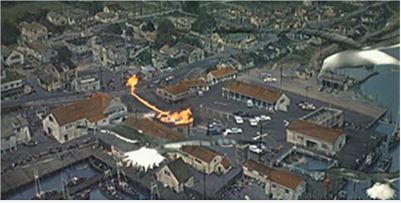
The two most famous matte paintings of the 1960s came from Mary Poppins and The Planet of the Apes.
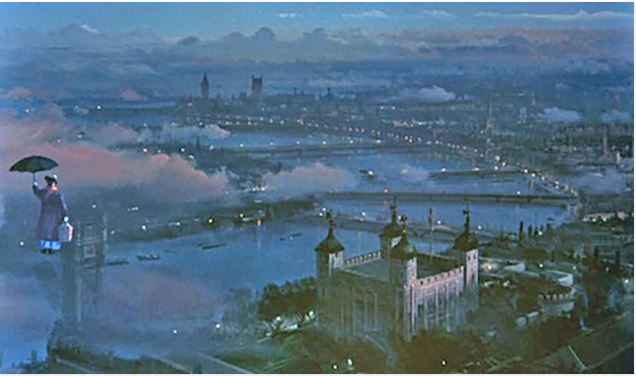

By the 1970s, the previously mentioned VFX masters at ILM would use many matte paintings to bring Star Wars to life. Star Wars had a multitude of great artists, like Christoper Evans. Evans created many of the iconic Star Wars images, like Darth Vader’s imperial march.



ILM was also responsible for creating the matte painting for the finale to Raiders to the Lost Ark. It took three months to paint all of the crates and boxes.

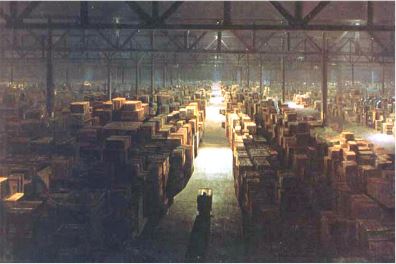
As technological advancements were made, matte paintings became digital renderings. One of the last hand painted mattes used in a major motion picture was in the 1997 epic, Titanic.

Digital Matte Paintings
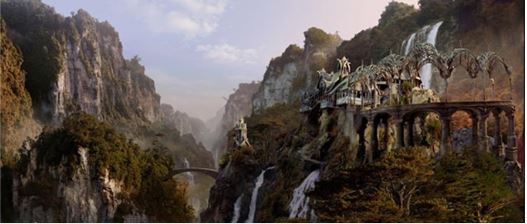
While most motion picture productions have moved to blue and green screens, the techniques used my matte painters are still applied to modern film-making. However background plates are often still hand drawn or painted. They are used as reference material for the digital artwork.
Matte paintings are also no longer created into two dimensional images. Entire 3D sets and backgrounds are created digitally. Even digital cameras are used to add movement. Although there are still films that will use matte paintings as backdrops. Such as in Harry Potter and the Prisoner of Azkaban, where six 100-foot canvases were stitched together and placed behind the set.
What is the purpose?
Matte painting, in both traditional form and its current digital form, is a film technique that combines art and live action to create the illusion of a setting that would otherwise be too expensive, inconvenient, or impossible to film live.
The basic principle of matte painting is that part of the scene is “masked off”, either with black material, green screens, or digital cropping.
Matte Artists
Before the computing era, ILM was the master of oil matte painting, making audiences believe that some of the sets in the original Star Wars and Indiana Jones trilogy were real when they weren’t. They were the work of geniuses like Chris Evans, Mike Pangrazio, Frank Ordaz, Harrison Ellenshaw, and Ralph McQuarrie.
Chris Evans
Born in 1954 in Bremerton, Washington, Chris Evans has created matte paintings for many iconic movies. Among them The Empire Strikes Back, Return of the Jedi, Indiana Jones and the Temple of Doom, Titanic, Willow, The Curious Case of Benjamin Button, and The Green Mile.
Mike Pangrazio
Mike Pangrazio didn’t have experience before joining ILM, so Ralph McQuarrie (the master himself) taught him how to do it over three years. One of his first jobs was the tractor beam matte in the first Star Wars.

He was responsible for setting up many key scenes in the history of cinema, most signifincatly the iconic final scene of Raiders of the Lost Ark, where a government official pushes the Ark down an aisle surrounded by thousands of crates (image as seen earlier). He now works for Weta Digital as art director. He also designed the current Walt Disney logo opening sequence.
RalphMcQuarrie
After starting his career as a technical illustrator for Boeing and animating the Apollo program coverage for CBS, legendary Academy Award Winner Ralph McQuarrie was the genius creative force behind the entire Star Wars films. In fact, many of his original concept art has served as the inspiration for the new JJ Abrams Star Wars film. During his long career, he did other seminal work, like designing the original Battlestar Galactica series and the spaceships for Close Encounters of the Third Kind and E.T.
Harrison Ellenshaw
With McQuarrie and Pangrazio, Harrison Ellenshaw was the third matte painter for the original Star Wars. He worked on A New Hope and oversaw the matte department on The Empire Strikes Back at George Lucas’ premier effects facility, ILM. He then went on to work for Disney in movies like Tron and The Black Hole, which got him and his father nominated for an Academy Award.
Here’s an image of Ellenshaw, McQuarrie, and Pangrazio taken during The Empire Strikes Back.

Frank Ordaz
At 10 he was studying with a portrait master by the name of Theodore N. Lukits. And he was also mentored by notable California Plein Air artist Sam Hyde Harris who was friends with Norman Rockwell. He grew up with stories by 2 men who were born in the 1800’s. And by the time he graduated Art Center College of Design and was already painting for the movie industry and was even hired by George Lucas’s company ILM. His first assignment was to paint a background establishing shot for ET. Steven Spielberg liked it and his career took off.
Matte Artist Feng Zhu has also contributed to some of the biggest films made by George Lucas, Steven Spielberg, James Cameron, Michael Bay and Luc Besson.

















